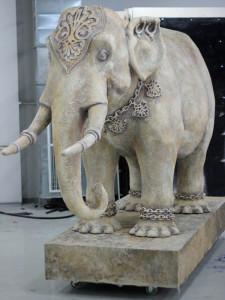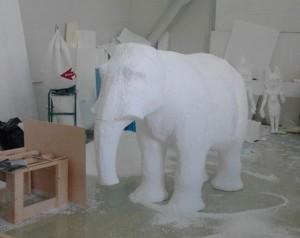 Any theatrical production requires a great deal of creativity from everyone involved – not just the actors and director, but the technicians and stage designers who have to work with an often limited amount of resources to manifest the director’s vision. I’ve worked in a lot of low-budget theatres, so I know firsthand that less money often correlates to more inventiveness. If my college theatre department taught me anything, it was how to repurpose things. We had a very small prop loft full of strange objects that had been reused, disassembled, reassembled, hacked, and painted over and over again for decades. Nothing was ever thrown out, because it was likely it would somehow be useful again someday. It looked like a hoarder’s lair, but that creepy little room turned out to be a gold mine for every production.
Any theatrical production requires a great deal of creativity from everyone involved – not just the actors and director, but the technicians and stage designers who have to work with an often limited amount of resources to manifest the director’s vision. I’ve worked in a lot of low-budget theatres, so I know firsthand that less money often correlates to more inventiveness. If my college theatre department taught me anything, it was how to repurpose things. We had a very small prop loft full of strange objects that had been reused, disassembled, reassembled, hacked, and painted over and over again for decades. Nothing was ever thrown out, because it was likely it would somehow be useful again someday. It looked like a hoarder’s lair, but that creepy little room turned out to be a gold mine for every production.
Moscow’s Bolshoi Theatre obviously has a much larger budget and more resources than any theatre I’ve ever worked in, but even well-funded productions require a lot of resourcefulness. Earlier this year, the theatre put on a production of La Bayadère (The Temple Dancer), a ballet that tells the story of a tragic romance set in India. The opulent set required quite a few large, complex pieces, including a lifelike elephant. It couldn’t be life-sized, obviously, but it needed to be big enough to be seen clearly from the back of the theatre, so the set designers settled on a 5-foot-tall statue.

 To build something this big, the designers started small. A sculptor created a small clay figure of the elephant, which was scanned using a RangeVision 3D scanner. The scan was converted into a CAD model and scaled up to 20 times its original size. The CAD model was then uploaded to a CNC foam carving machine, which cut the 150 cm high elephant from a large block of lightweight foam material. The elephant was then coated, painted, and intricately decorated before taking its place onstage.
To build something this big, the designers started small. A sculptor created a small clay figure of the elephant, which was scanned using a RangeVision 3D scanner. The scan was converted into a CAD model and scaled up to 20 times its original size. The CAD model was then uploaded to a CNC foam carving machine, which cut the 150 cm high elephant from a large block of lightweight foam material. The elephant was then coated, painted, and intricately decorated before taking its place onstage.
Anyone looking at the finished elephant would easily assume that it had been carved out of stone, but the foam material allowed for the elephant to be deceptively lightweight. Moreover, its construction, thanks to the 3D scanner and CNC machine, was a breeze, requiring very little time or money. The Bolshoi theatre has been creating a lot of its props and set pieces using this method.
“Scanning takes about 6 minutes and as a result we get an accurate and highly detailed 3D model in colour,” said scene decorator Ivan Petrov. “Such model can be stored for years, you don’t need any space for it, which is important, when you have limited storage facilities. What’s more, unlike clay or other materials, it is resistant to negative effects of atmosphere and time.”
I’m trying to imagine how my college theatre days would have been different if we had had a 3D scanner. Rather than a cramped, allegedly haunted room packed with physical objects, a digital library of 3D scanned props would have made things much easier to store, catalog and modify if necessary. Although, if I’m honest with myself, it probably wouldn’t have been nearly as much fun. Discuss this story in the 3D Scanning a Giant Elephant forum on 3DPB.com.
Subscribe to Our Email Newsletter
Stay up-to-date on all the latest news from the 3D printing industry and receive information and offers from third party vendors.
Print Services
Upload your 3D Models and get them printed quickly and efficiently.
You May Also Like
The Market and Industry Potential of Multi-Material 3D and 4D Printing in Additive Electronics
Additive manufacturing leverages computer-based software to create components for products by depositing either dielectric or conductive materials, layer by layer, into different geometric shapes. Since its birth in the 1980s,...
3DPOD 262: Bio-inspired Design for AM with Dhruv Bhate, Arizona State University
Dhruv Bhate is an associate professor at Arizona State University. There, he looks at structures, materials, and design. Previously, he worked at PADT as well as in the semiconductor and...
3DPOD 261: Tooling and Cooling for AM with Jason Murphy, NXC MFG
Jason Murphy´s NXC MFG (Next Chapter Manufacturing) is not a generalist service; instead, the company specializes in making tooling. Using LPBF and binder jet, the company produces some of the...
3DPOD 260: John Hart on VulcanForms, MIT, Desktop Metal and More
John Hart is a Professor at MIT; he´s also the director of the Laboratory for Manufacturing and Productivity as well as the director of the Center for Advanced Production Technologies....
































